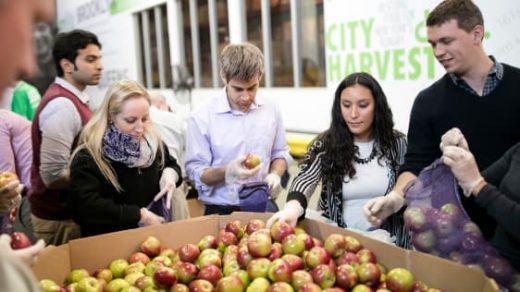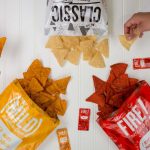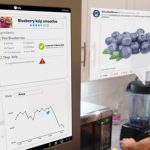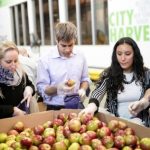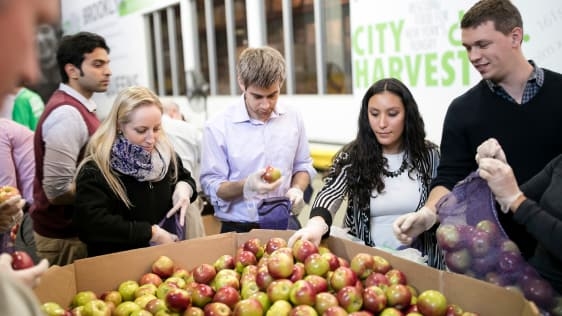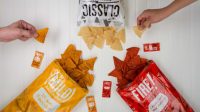Food Banks’ Massive Plan To Move From Canned Goods To Fresh Produce
On the Thursday before Thanksgiving, in a room inside City Harvest’s 45,500-square-foot distribution warehouse at the southern tip of Long Island City, Queens, around 30 volunteers assemble boxes and move them down a makeshift assembly line, where others fill them with ingredients for a holiday meal: bags of sweet potatoes, stripetti and delicata squash, canned beans and pumpkin.
Despite the ubiquity of canned food drives, particularly around the holidays, the canned items, says Max Hoffman, City Harvest’s food sourcing manager, are somewhat of an anomaly in the LIC warehouse: Over 50% of the food that City Harvest distributes is fresh produce. That makes the New York City nonprofit somewhat of an anomaly–with a few notable exceptions, mainly in California, produce makes up less than 10% of standard food bank inventory.
Feeding America, the nation’s largest hunger-relief organization (its annual budget nears $30 million), wants to make City Harvest’s produce parity the norm for food banks, rather than the exception. In the past year and a half, the nonprofit and parent organization of a network of 200 food banks (of which City Harvest is a part) launched an effort to mitigate food waste and close the nutrition gap by developing a new system to source excess produce and distribute it to its food banks across the country. Since 2014, before Feeding America launched this initiative, they’ve increased the annual amount of produce sourced by nearly 500 million pounds.
Feeding America’s new strategy has entailed building out regional produce cooperatives to which farmers could bring their surplus crops, essentially creating a physical link between growers and the hunger-relief nonprofit. While some food banks have connections with local growers, for the majority of their history, food banks have not been set up to accommodate and move fresh food. Changing that will reduce waste and ensure that hungry people are fed not with empty, unhealthy calories, but with fresh, nutritious food.
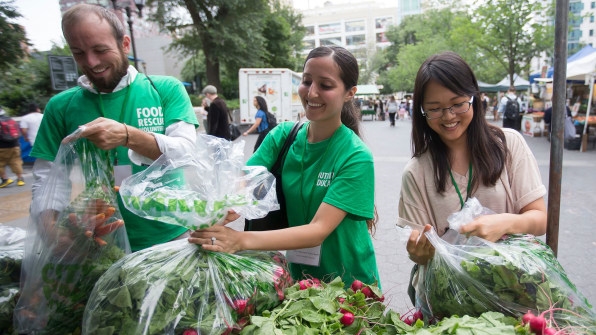
[Photo: City Harvest]
Food Banks’ Shelf-Stable History
As recently as just a few years ago, says Bill Thomas, chief supply chain officer at Feeding America, “our main focus was shelf-stable food.” Feeding America reaches 46 million people through its food banks and associated food pantries, soup kitchen, shelters, and other agencies. While some of the network’s food banks have, in recent years, adopted more aggressive produce-sourcing strategies, they mainly receive and distribute bulk shipments of non-perishable items like dried and canned foods.
Since its founding in 1982, City Harvest has done things differently. The nonprofit began when a group of concerned citizens, upset by the amount of excess food tossed to the city’s curbs, began driving around to restaurants and grocery stores to collect still-edible perishables, and bring them to New Yorkers in need. Since then, the organization has scaled up to the point where it’s able to rescue and redistribute 150,000 pounds of food per day around the five boroughs.
Through its long history of handling produce and perishables, City Harvest has learned a series of best practices: It’s installed a 4,000-square-foot freezer and a 5,300-square-foot cooler in the LIC facility; It’s developed relationships with local restaurants and stores that will automatically funnel their leftovers toward their cause; it’s made arrangements with regional produce growers who will, says director of warehouse operations Jim Dunne, treat City Harvest “as a secondary marketplace” for produce that, mainly for aesthetic reasons, wouldn’t pass muster in a mainstream store like Whole Foods. And City Harvest has to work closely to coordinate with their network of food pantries and soup kitchen to whom they deliver to ensure that they’ll be able to make use of the food they can bring them.
Contrast that to the way most of the food banks under Feeding America’s network operate: The more standard system runs something like this, to paraphrase Slate: A large manufacturer like Kraft will alert Feeding America to an excess of say, boxed mac and cheese, that they can’t place in supermarkets and will otherwise have to toss. Feeding America’s central office would then coordinate the distribution among its food banks, allocating the shipment based on need and proximity to the pickup point.
The Problem With No Produce
Food banks can acquire and store shelf-stable foods. But the issue is that non-perishable food often falls toward the unhealthy end of the dietary spectrum. The USDA recommends that of the staple four food groups of dairy, grains, proteins, and produce, at least three of the four categories should be fulfilled with perishable food choices.
Not only are perishable foods, and produce in particular, more nutritious, but they also constitute a huge portion of food waste in America. Around 50%–60 million tons–of all produce in the U.S. is thrown away each year. Much of that is tossed for aesthetic reasons, despite the fact that it’s still perfectly edible (the high volume of waste has originated various efforts to reclaim “ugly produce” for its nutritional content).
“We know from our work with organizations like ReFED that Americans waste around 72 billion pounds of food each year,” Thomas says. “Typically, we’ve played in the middle of that supply chain, working with manufacturers and large retailers, and the waste in that sector is around 2 billion pounds.” At the front end of the supply chain–growers, packers, shippers–waste totals around 20 billion pounds. The opposite end, which includes restaurants, grocery stores, and small shops, wastes 50 billion pounds per year.
A Dual Approach To Tackling Food Waste
While Feeding America continues to source from major manufacturers and companies like Kraft and Wal-Mart, lately, it’s turned its attention to the more extreme ends of the supply chain.
This past spring, after a three-year pilot period, Feeding America launched MealConnect, a platform to connect businesses within that latter category, like coffee shops and farmers markets, wishing to donate excess food with nearby food banks or affiliated pantries and soup kitchens. In a sense, it allows other agencies to adopt, with relative ease, strategies similar to those City Harvest has been using for decades. On MealConnect, businesses can create a free account, upload information about the excess food they have and when they’d like it to be picked up, and Feeding America’s algorithm will match the donation to an affiliate, who will collect the food. So far, the platform has facilitated 737,000 pickups and moved over 333 million pounds of food–enough for 278 million meals.
While MealConnect is effectively using tech to being to tackle the insane amount of perishable food waste that happens at the consumer-facing end of the supply chain, pinning down a solution to waste at the front end necessitated a fairly substantial systems shift for Feeding America.
Around a year and a half ago, Feeding America set up six regional produce cooperatives, also known as “mixing centers” across the U.S. The cooperatives–in Indiana, Minnesota, Georgia, Pennsylvania, Washington, and Texas–join an already-existing center in California, which served as the model for Feeding America’s wider plan.
With a $3 million investment from Feeding America’s budget and a $1.3 million grant from Target, the produce cooperatives enable Feeding America to source large quantities of produce from farmers and growers, and deliver it out to its network of food banks. In their first year, the seven co-ops collectively sourced over 160 million pounds of produce. “On the produce side, it’s more challenging, because unlike with shelf-stable foods, you have to move it quickly–and not just to the food banks, but to people’s tables,” says Celia Cole, CEO of Feeding Texas, the state’s Feeding America subsidiary.
Cole oversaw the launch of the first of Feeding America’s new produce cooperatives in the summer of 2016. The southwest Texas co-op, she says, has, along with the mixing center in California, guided the newer co-ops as they’ve developed their strategies. “We’ve really worked to figure out how to capture the most surplus that we can,” Cole says. In Texas, around 350 million pounds of produce goes to waste each year. Feeding Texas began by alerting regional produce growers to the new mixing center in the state’s main growing region. “We’re working on striking deals with the growers so that they turn to us when they have surplus,” Cole says.
Farmers often can’t predict the results of their harvests, and an unexpected bumper crop of say, potatoes, one season, could land them with an excess they might have no other outlet for. On top of that, Feeding Texas will offer the growers around 10 cents per pound of surplus crops that they deliver–a low enough sum to qualify the shipment as a donation (and as a result, merit a tax deduction), but high enough, Cole says, to create an incentive for the farmers to participate.
Once the farmers bring their surplus crops to the cooperative, the staff there mix and package the produce into smaller shipments that then go out to the food banks. “One of the first lessons we learned when we were putting together this model was that we need to get produce out in smaller quantities that the food banks can use,” Cole says. The food banks, she says, will never be able to move a whole truckload of cabbages, but if they receive a shipment from the mixing center that has five different items–say, not only cabbage, but also kale, potatoes, onions, and carrots–then the food banks will be able to bundle the items and deliver them to pantries as key ingredients in healthy meals. In a sense, they’re following the format that City Harvest has been championing through its Thanksgiving deliveries.
So far, the Southwest Regional Cooperative in Texas can capture and distribute around 70 million pounds of produce–a fifth of the state’s total surplus, Cole says. As the mixing center models become more solidified, and as more farmers begin turning to the co-ops as a reliable repository for their surplus, that number, Cole says, will grow.
Feeding America’s goal is to ensure that by 2025, half of the food they distribute to people in need will be fresh fruits and vegetables. Still in the early stages, the regional produce cooperatives seem to be pointing the organization toward meeting that goal. City Harvest is anticipating that they’ll be able to source an additional 2 million pounds of produce from their nearest mixing center, the Mid-Atlantic Regional Cooperative, by the end of this fiscal year. In Texas, each of the 21 food banks serviced by the Southwest Regional Cooperative received around 3.5 million pounds of produce to distribute.
Seeing the volume of produce that Feeding America has been able to rescue and redistribute through this new program, though, also serves to cast the amount of excess food that it’s not able to capture in a harsher light. Speaking to the nonprofit Food Tank, the food security expert Andrew Fisher says that the tactic of sourcing food that would otherwise be wasted to feed people in need “points to the way we think about the hunger problem [in the United States] in a very downstream kind of way.” Arguing that food charity perpetuates the structural inequalities in the country that lead people to depend on donated food in the first place, Fisher wants to see food banks start to act more as engines of economic development, and less as charitable organizations. In that, he’s not alone: A 2016 report from the nonprofit WhyHunger entitled “America’s Food Banks Say Charity Won’t End Hunger” lays out a call to shift the roughly $17.8 billion annual charitable donations to hunger relief efforts toward investments in local farms and food systems that could create economic activity and provide in-need communities with food.
The total cost burden of food insecurity in the U.S. is $167.5 billion; the economic losses associated with food waste in the U.S. total over $160 billion. It’s not hard to see how tackling one issue could work to alleviate the other, but beyond that, we as a country have to think much more rigorously about how to redesign the systems that perpetuate both.
Fast Company , Read Full Story
(54)

